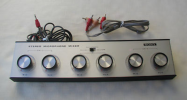My goal is to mix multiple stereo signals to send a single signal to my preamplifier. Three questions concern me:

- Should I prefer an active or passive mixer? I know that a passive mixer will reduce the overall volume, which is not a problem because I have a sufficient gain reserve. I was hoping that the passive mixer would avoid adding any noise or distortion, unlike an active one, but I would like your technical opinion on this.
- If a passive mixer is acceptable, is there any advantage to giving up potentiometers that allow me to balance the inputs on the fly in a centralized location in favor of a model with simple ON/OFF buttons?
- Could I risk having "hum" issues for any reason? I don't see how a ground loop could happen here, but this seems a complex topic. The devices connected to the mixer would be:
- Analog DAC output (powered and fed via PC USB)
- Guitar effects processor (powered and controlled via PC USB, fed by guitar jack)
- Microphone return, useful for online gaming sessions (powered via PC USB, fed by VModa Boom Pro)
- Echo Auto (powered via PC USB)



